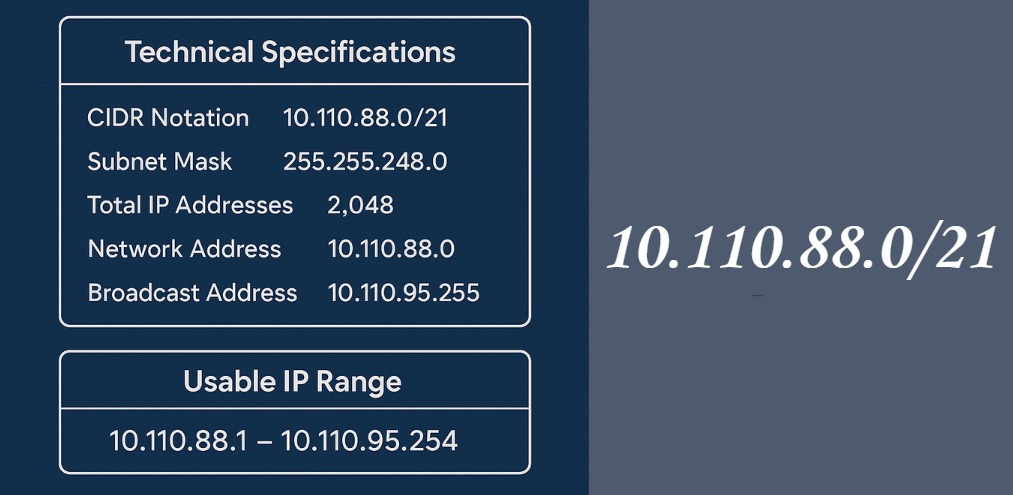A Complete Guide to Understanding 10.110.88.0/21 Subnet
The IP address block 10.110.88.0/21 is part of the larger private IP address space defined by the Internet Engineering Task Force (IETF) under RFC 1918. This specific subnet is not publicly routable on the internet, which makes it ideal for use within private networks such as businesses, schools, and enterprise data centers.
To break down the notation: the “/21” refers to the subnet mask that determines how many IP addresses are available in this network. In this case, it indicates that the first 21 bits are reserved for the network part, leaving the remaining 11 bits for host addresses.
Private address ranges like this one allow organizations to use internal networking without requiring public IP addresses, which are limited and often costly. The 10.110.88.0/21 subnet is especially useful for medium to large-scale deployments that need around 2,000 IPs.
Technical Specifications of 10.110.88.0/21
Understanding the technical details of this subnet helps you make efficient use of it within your internal network. Here’s a summary of what the subnet looks like:
| Property | Value |
|---|---|
| CIDR Notation | 10.110.88.0/21 |
| Subnet Mask | 255.255.248.0 |
| Total IP Addresses | 2,048 |
| Usable IP Addresses | 2,046 (excluding .0 & .255) |
| Network Address | 10.110.88.0 |
| Broadcast Address | 10.110.95.255 |
| Usable IP Range | 10.110.88.1 – 10.110.95.254 |
As you can see, the 10.110.88.0/21 block provides a healthy number of usable IP addresses, making it well-suited for organizations with multiple departments, devices, or users requiring unique addresses within the same internal network.
Subnetting the 10.110.88.0/21 Block
One of the strengths of working with this subnet is its flexibility. You can divide it further into smaller subnets depending on the size and needs of your organization. This process is called subnetting, and it helps manage traffic more effectively while isolating departments or functions for security and performance.
Here’s how you can break down 10.110.88.0/21 into smaller subnets:
- /22 Subnets – Splitting into two equal parts gives you two subnets with 1,022 usable IPs each:
- 10.110.88.0/22
- 10.110.92.0/22
- /23 Subnets – Four subnets each providing 510 usable addresses:
- 10.110.88.0/23
- 10.110.90.0/23
- 10.110.92.0/23
- 10.110.94.0/23
- /24 Subnets – Eight subnets with 254 usable IPs each:
- 10.110.88.0/24 through 10.110.95.0/24
This breakdown shows how versatile the 10.110.88.0/21 range is. It can be sliced up for different floors of a building, different teams, or even services like VoIP, printers, and guest networks. Each subnet remains logically and securely separated from the others while being part of the same overarching network.
Real-World Applications of 10.110.88.0/21
This IP block is commonly used in a variety of real-world environments. In corporate settings, it’s often used to assign internal IPs to:
- Employee workstations
- Printers and scanners
- VOIP phones and communication devices
- File and application servers
- Virtual machines or containers within a data center
- Guest Wi-Fi or isolated networks
For example, an organization might allocate:
- 10.110.88.0/24 for its IT department
- 10.110.89.0/24 for Finance
- 10.110.90.0/24 for HR
- 10.110.91.0/24 for Remote Access VPN users
Such segmentation allows better tracking, enhanced performance, and easier troubleshooting.
Advantages of Using 10.110.88.0/21
There are numerous benefits to utilizing a subnet like 10.110.88.0/21 in private networking:
- Scalability – With over 2,000 IPs, this block comfortably accommodates growing organizations.
- Internal Use Without Public IPs – Reduces reliance on expensive public addresses.
- Enhanced Security – Being a private range, it’s not accessible from the internet, reducing external threats.
- Efficient Network Management – Logical segmentation improves network control, maintenance, and monitoring.
- Flexibility – The subnet can be easily divided into smaller chunks to suit departmental needs.
These advantages make it a go-to choice for infrastructure planning, especially in enterprise networks, campus environments, and complex data center topologies.
Security Considerations
Although 10.110.88.0/21 is not directly accessible from the internet, that doesn’t mean it’s entirely secure. Internal networks are still vulnerable to threats such as malware, insider attacks, or lateral movement after an initial breach. Therefore, implementing strong internal security policies is essential.
Some best practices include:
- Deploying internal firewalls or segmentation gateways between subnets.
- Using access control lists (ACLs) to restrict communication.
- Enabling intrusion detection and prevention systems (IDPS).
- Regularly updating and patching all connected devices.
Even within private IP space, secure architecture is key to protecting sensitive data and maintaining business continuity.
Conclusion
The 10.110.88.0/21 subnet represents a highly flexible and practical private IP block for internal network design. It offers enough IP addresses to serve medium to large networks and is easily subdivided to match organizational needs. When planned and secured correctly, this subnet can support everything from daily business operations to complex cloud environments.
Whether you’re a network engineer designing a new infrastructure or a student learning about subnetting, mastering 10.110.88.0/21 will deepen your understanding of IP addressing, routing, and network architecture.
Recommended Articles
RT69264 10-Hook Rack: The Ultimate Space-Saving Organizer for Every Room
Profile Mia66 from Portland, Maine: An Inspiring Story of Creativity, Community, and Purpose
Hura-Watch.net Quest of the Eternal Realm: A Complete Exploration of the Epic Adventure
Planta Fluidos de Perforación en Punata Camacho Edo. Zulia: A Comprehensive Insight






